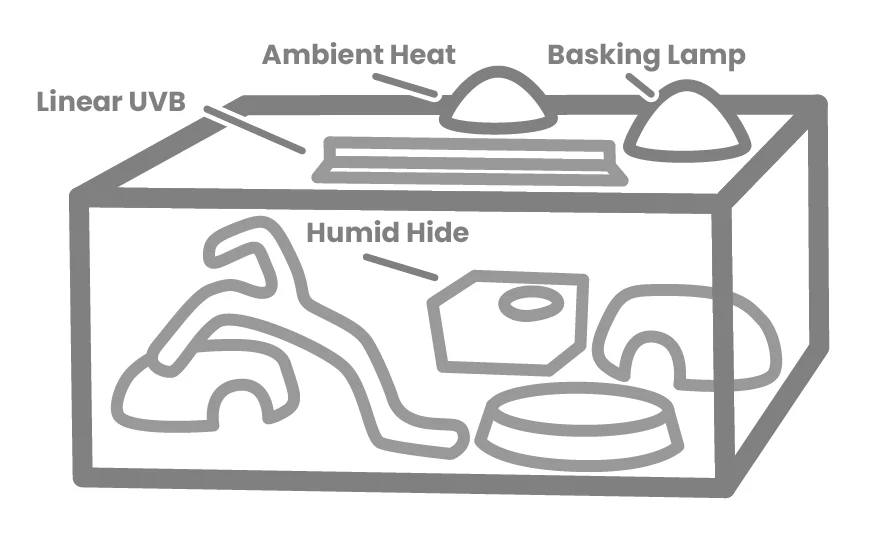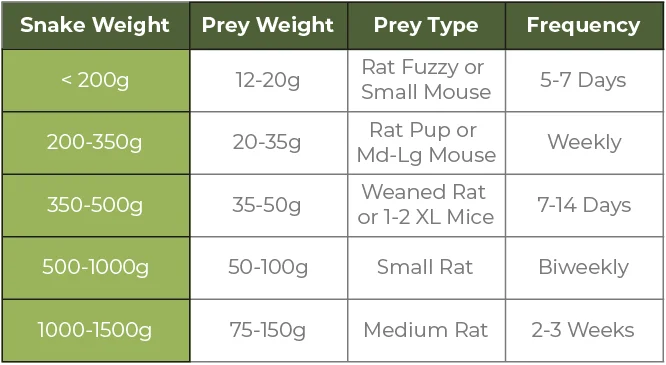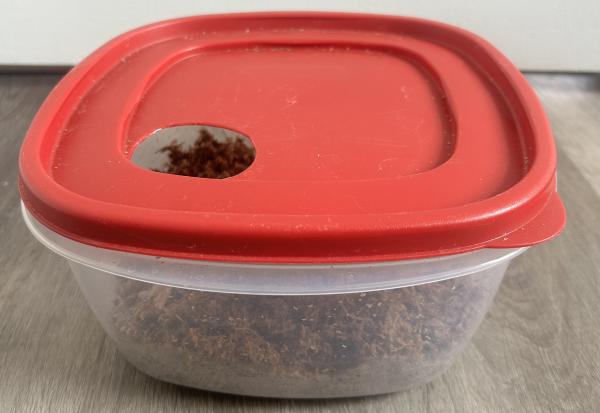Ball Python Care Guide
Python regius
Ball pythons (Python regius) are medium-sized constrictors from sub-Saharan Africa, where they inhabit grasslands and forests. Heat-sensing pits along their upper jaw help these crepuscular hunters detect warm-blooded prey, even in darkness. They are slower moving, docile snakes, though they do enjoy exploring their environment in and out of their enclosure.
- Native range: West Sub Saharan Africa from Senegal through Cameroon to Sudan and Uganda
- Conservation status: Least Concern
- Captive lifespan: 20-30 years
- Diet: Small mammals and birds

Photo: Reptifiles – Ball Python Care Guide
Enclosure Setup
Enclosure Size
- Juveniles – 3’x18”x18”
- Adults – 4’x2’x2’ or larger
Herp Habitat does NOT endorse the use of bins or rack systems.
Like many snakes, ball pythons can be escape artists. Check to make sure all walls and screens are secure, and use lid locks if needed.
Heat & Humidity
- Basking spot: 90-95F
- Warm side: 80-85F
- Cool side: 70-80F
- Night temp: 70-80F
- UVB: 5.0 shade dweller
- Humidity: 50-60% (80-90% during shed)
Environment
- Lifestyle: primarily terrestrial though they do like to climb!
- At least 2 snug hides
- At least 1 humid hide
- Climbing branches
- Water dish large enough to soak in
Enclosure Setup Example (simplified)

Keep in mind that ball pythons do need a day and night cycle for their heat and light even though they are more active in the darker hours.
Substrate
When choosing a substrate for your ball python, consider its humidity retention, cleanliness, your snakes ability to move throughout it and burrow, and the cost. Full substrate replacements are needed every four months. Waste can seep into the bedding, and mold may develop in humid areas, especially under water bowls, so regular checks are essential. Bioactive is also an option, just keep in mind you will need a drainage layer underneath and a thicker substrate layer on top.
RECOMMENDED:
- Paper towel (for quarantine)
- Coconut chips (Reptichip)
- Cypress mulch
- ReptiSoil
- Eco Earth
- A mix of organic topsoil, sphagnum moss, and coconut chips or cypress mulch
DO NOT USE:
- Reptile carpet
- Aspen shavings/chips
- Pine shavings
- Cedar shavings
Diet
Feeding Guide

*This guide provides general guidelines and recommendations, but for optimal health keep track of their weight and adjust feeding as necessary.
Feeding Guide
Mice and rats are staple feeders due to their balanced nutrition and availability, though wild ball pythons will eat a range of small mammals, birds, and occasionally even reptiles. Here are some alternative feeders that can add beneficial variety.
- African soft-furred rats
- Gerbils
- Hamsters
- Young guinea pigs
- Young rabbits
- Chicks
- Quail chicks
Ball Python Feeding Info
Frozen thawed VS. live – Frozen-thawed prey is safer and more humane than live feeding, reducing injury risks and exposure to parasites. It also ensures consistent nutrition and prevents unnecessary suffering for both the snake and its prey.
How to thaw F/T? – Thaw frozen rodents in the fridge overnight, then optionally soak them in slightly warm water for five minutes before feeding to reach a natural body temperature. Avoid hot water or microwaves, as they can cook the prey unevenly.
Where to buy rodents? – Avoid large chain pet stores as they will be overly expensive and low quality. Instead try:
- Ordering bulk online
- At reptile expos
- Local breeders (reach out on Facebook to find one!)
Sporadic feeding – Feeding on a more random schedule actually mimics a ball python’s opportunistic predator hunting patterns. Varying feeding intervals in captivity can promote a healthier metabolism and reduce food anticipation stress.
NOTE: Sporadic feeding will require you to put extra effort into tracking how often and how much they are eating, as they still need to eat the same total amount over time.
Supplementation – Ball pythons can actually hugely benefit from the occasional calcium + multivitamin with D3 supplement dusting.
FUN FACT: In the wild, male ball pythons have been observed climbing trees to hunt birds, a behavior linked to their smaller size and agility. Females, being larger and heavier, prefer hunting larger ground-dwelling prey like rodents, making tree climbing less necessary.
Shedding
Ball pythons shed their skin periodically as they grow, typically every 4–6 weeks for juveniles and a few times per year for adults. The shedding process begins with a dulling of their scales and a blueish, cloudy appearance in their eyes, known as “going blue.” This phase lasts a few days before their eyes clear up and their scales actually look less dull signaling that the shed is about to happen. Within a few days to a week, they should shed in one complete piece.
Raising Humidity During Sheds
You can assist the shedding process and ensure a smooth and whole shed two ways, by raising humidity and ensuring access to a humid hide. We recommend doing both! You can raise humidity in the enclosure by misting or spraying down the enclosure until the humidity reaches up to 90% humidity (a hygrometer will be necessary to check humidity levels).
Helping With An Incomplete Shed
To help a ball python with stuck shed, soak it in a shallow container with 85–90°F (29–32°C) water for 10–20 minutes, ensuring the water is just deep enough to cover its body. Add a rock or something stable and gippy for them to grab onto in their bath. After soaking, gently rub any remaining shed with a damp paper towel or soft cloth, always moving in the direction of the scales. Never force shed off, especially around the eyes or tail tip. If stubborn pieces remain, repeat the process over the next few days. And remember that prevention is the biggest focus, so use this as a sign to work on your humidity for next time!
How To Make a Humid Hide

To make a humid hide, use a sturdy, enclosed container like a plastic tub with a lid, and cut a whole just big enough for your snake it fit through. Fill it with moisture-retaining substrate, we recommend sphagnum moss. Keep the substrate damp but not soaking, as standing water could lead to scale rot, and place the hide on the warm side of the enclosure to maintain humidity. Regularly check for mold and refresh the moisture as needed.
Continuing Care
Monitoring Health & Behavior
Regularly observing your ball python’s behavior and physical condition is key to ensuring their long-term health. A healthy ball python should be alert, have a steady appetite, show normal movement, and shed in one complete piece. It’s also good to regularly monitor weight, appearance of scales, their vent, and their heat pits. Changes in behavior or appearance can be early signs of health issues.
What to Watch For:
Changes in Appetite:
- Occasional fasting is normal, especially in colder months or breeding season. However, prolonged refusal to eat (months at a time) may indicate stress, improper temperatures, illness, or internal parasites. We do not encourage the normalizing of “hunger strikes” and we urge keepers to always investigate changes in behavior, even if they are seemingly normal.
Shedding Issues:
- Difficulty shedding (dysecdysis) or incomplete sheds can result from low humidity, dehydration, or underlying health problems. Stuck shed on the eyes (eye caps) can impair vision and should be addressed carefully.
Respiratory Issues:
- Open-mouth breathing, wheezing, mucus around the mouth or nose, and excessive yawning could indicate a respiratory infection, often caused by improper humidity or temperature.
Lethargy or Unusual Hiding Behavior:
- While ball pythons are naturally sedentary, extreme inactivity or spending excessive time in one part of the enclosure (like the cool side) may signal illness or stress.
Scale Rot or Skin Infections:
- Discolored or blistered scales, especially on the belly, are often caused by prolonged exposure to damp or soiled substrate.
Mouth Rot (Stomatitis):
- Swollen gums, pus, or excessive drooling can be signs of infection, which can result from poor husbandry or injury.
Mites and Parasites:
- Tiny black dots moving along the snake’s body or soaking excessively in water may indicate mites. Internal parasites can cause weight loss and irregular stool.
Thermostat Use
A thermostat is essential for regulating heat sources like heat mats and deep heat projectors, which can become dangerously hot if left unregulated. The thermostat probe must be securely placed as close to the heat source as you can, such as between the heat mat and the enclosure floor or near a deep heat projector’s output. The goal is to use the probe to maintain a consistent desired temperature in the tank. Then you will need to measure the temperature where your snake rests using an infrared thermometer or a digital probe, and adjust your thermostat temperature until the snakes resting spot is the correct temperature. The reading on your thermostat will be higher than your snakes actual required resting spot temperature since the probe is only stabilizing the temperature, but the specific temperature that is important is the temperature where you snake is.
UVB
While ball pythons are primarily nocturnal, UVB lighting can still offer benefits, particularly for those that bask or explore during the day. UVB aids in vitamin D3 synthesis, supporting calcium metabolism and bone health, though a properly supplemented diet can also provide this. A low-output UVB bulb, such as a 5-7% T5 or 5% T8, can be beneficial if positioned over a screened area of the enclosure, allowing the snake to choose exposure. However, for ball pythons that rarely leave their hides during daylight hours, UVB is less impactful since they would not naturally receive much sun exposure, making occasional vitamin D3 supplementation especially helpful in preventing deficiencies. Researchers are continuing to look into the benefits of UVB for ball pythons, but so far all signs point to UVB being a positive addition that can encourage more natural behaviors and enhance overall well-being for snakes that utilize it.
Feeding Tips
When feeding your ball python, it’s best to offer food inside the enclosure to minimize stress before feeding. Always use feeding tongs to present the rodent, as this prevents accidental bites and helps your snake recognize food. When feeding frozen-thawed prey, briefly soak prey in lukewarm water to bring up its temperature since ball python’s use their heat-sensing pits to hunt their prey. Ensure the feeding area is clean and free of loose substrate to prevent ingestion, and give your snake time to eat undisturbed. Lastly, since ball pythons are crepuscular, they are more likely to accept food in the evening or after their enclosure lights have dimmed, making nighttime the ideal time to offer meals.
Choosing The Right Hides
Ball pythons prefer snug hides that make them feel secure, often choosing a the better fit over the ideal temperature. If given two different hides, one on the warm side and the other on the cold side, they may prioritize the cozier hide rather than the one in the optimal temperature range. To prevent this, provide identical hides, at least one on each side, so your snake can regulate its temperature without sacrificing security.
Additional Products
You may be a bit overwhelmed by all of this info… well the good news is that ball pythons are not too much work day to day, and once the enclosure is properly set up, everything else should be smooth sailing! However, here are a few more things you may want to have on hand:
- Infrared thermometer gun – We strongly recommend the far more versatile and accurate temp gun over in-tank stick on thermometers
- Hygrometer – A humidity gauge is essential to monitoring moisture in the air (keep an eye on it as seasons change)
- Timer for lights – Something like an outlet timer so you don’t have to be manually turning light on and off
- Feeding tongs – Essential for safe feedings, just make sure to clean them each time after use
- Animal safe disinfectant – F10 Veterinary Disinfectant, Chlorhexidine Solution, water + white vinegar (research for more options)
- Tub for baths or saunas – Ideally it should be not too big and not too small, easy to clean, have a lid, and it should be opaque
- Freezer backup plan – Ideally to save money you will want to buy your F/T rodents in bulk, however it’s still not cheap and one power outage or malfunctioning freezer can cause a premature thaw, rendering that food unsafe to feed. Make a backup plan to avoid this from happening!
Many parts of this guide have information sourced from reptifiles.com, kpexotics.com, and various other websites. However, all information was evaluated by Herp Habitat and presented in a way that is true to our experience keeping ball pythons, and in a way that we hope both new and seasoned reptile keepers can understand and take something away from. See issues with our care guide? Reach out! We are always learning and open to new information.
